Students get through the TN Board 11th Bio Botany Important Questions Chapter 4 Reproductive Morphology which is useful for their exam preparation.
TN State Board 11th Bio Botany Important Questions Chapter 4 Reproductive Morphology
Answer the following short answers.
Question 1.
Define floriculture.
Answer:
Floriculture is a branch of Horticulture. It deals with the cultivation of flowers and ornamental crops.
Question 2.
What is axillary inflorescences?
Answer:
Inflorescence present in the axile of the nearest vegetative leaf.
Question 3.
What is meant by spadix inflorescences?
Answer:
An inflorescence with a fleshy or thickened central axis that possesses many unisexual sessile flowers in acropetal succession.
![]()
Question 4.
Define Capitulum.
Answer:
The capitulum is a determinate or indeterminate, group of sessile or subsessile flowers arising on a receptacle, often subten&d by an involucre.
Question 5.
What do you know about Helicoid?
Answer:
Axis develops on only one side and forms a coil structure at least at the earlier development stage. Example: Hamelia, potato.
Question 6.
Define Cymule.
Answer:
A small, simple dichasium is called a cymule
Question 7.
Explain briefly about coenanthium.
Answer:
Circular disc-like fleshy open receptacle that bears pistillate flowers at the center and staminate flowers at the periphery. Example: Dorstenia
Question 8.
Define bisexual flower.
Answer:
When a flower contains both androecium and gynoecium is called a perfect flower.
![]()
Question 9.
What is meant by polygamous plants?
Answer:
The condition in which bisexual and unisexual (staminate/pistillate) flowers occur in the same plaint is called polygamous.
Question 10.
Explain Actinomorphic flower.
Answer:
The flower shows two mirror images when cut in any plane or radius through the center.
Normally there are more than two planes of symmetry.
Question 11.
What do you know about merosity?
Answer:
A number of floral parts per whorl are called merosity. Perianth merosity is the number of perianth parts per whorl.
Question 12.
Describe briefly deciduous calyx.
Answer:
Calyx that falls after the opening of flower (anthesis) eg. Nelumbo.
Question 13.
What type of calyx is present in Ocimum?
Answer:
Two lipped calyces is present in Ocimum.
Question 14.
Define infundibuliform corolla.
Answer:
Petals fused to form funnel-shaped corolla. Tube gradually widens into limbs, eg. Datura, Ipomoea.
![]()
Question 15.
Mention three parts of the stamen.
Answer:
- Filament,
- Anther,
- Connective.
Question 16.
Define the term “Connation”.
Answer:
Connation refers to the fusion of stamens among themselves.
Question 17.
Explain briefly about the Apocarpous ovary.
Answer:
A pistil contains two or more distinct carpels, eg. Annona
Question 18.
Describe Gynobasic style with an example.
Answer:
Arising from the base of the ovary, eg. Lamiaceae (Ocimum), characteristic of Boraginaceae.
Question 19.
What is meant by pomology?
Answer:
The branch of horticulture that deals with the study of fruits and their cultivation are called pomology.
Question 20.
Write down two important functions of seed.
Answer:
- The seed encloses and protects the embryo for the next generation.
- It contains food for the development of the embryo.
![]()
Answer In brief.
Question 1.
Distinguish between racemose and cymose inflorescence.
Answer:
| Racemose | Cymose |
| The main axis of unlimited growth. | The main axis of limited growth. |
| Flowers arranged in acropetal succession. | Flowers arranged in a basipetal succession. |
| The opening of flowers is centripetal. | The opening of flowers is centrifugal. |
| Usually the oldest flower at the base of the inflorescence axis. | Usually the oldest flower at the top of the inflorescence axis. |
Question 2.
Explain the term “Hypanthodium” with a suitable example.
Answer:
A receptacle is a hollow, globose structure consisting of unisexual flowers present on the inner wall of the receptacle. The receptacle is closed except for a small opening called the ostiole which is covered by a series of bracts. Male flowers are present nearer to the ostiole, female and neutral flowers are found in a mixed manner from the middle below, eg. Ficus sp. (Banyan and Pipal).
Question 3.
Describe briefly the three types of sympetalous zygomorphic corolla.
Answer:
- Bilabiate: Corolla with two lips. eg. Ocimum, Leucas, Adhatoda. Tubular corolla with a single strap-shaped limb. eg. Ray floret of Helianthus.
- Personate: Corolla made up of two lips with the upper arched and the lower protruding into the corolla throat, eg. Antirrhinum, Linaria.
- Ligulate: Tubular corolla with a single strap-shaped limb, eg. Ray floret of Helianthus.
![]()
Question 4.
What is meant by anther dehiscence? Explain the different kinds of anther dehiscence.
Answer:
It refers to the opening of anther to disperse pollen grains.
- Longitudinal: Anther dehisces along, a suture parallel to the long axis of each anther lobe, eg. Datura, china rose, cotton.
- Transverse: Anther dehisces at right angles to the long axis of anther lobe. eg. Malvaceae.
- Poricidal: Anther dehisces through pores at one end of the thecae, eg. Ericaceae, Solanum, potato, brinjal, Cassia.
- Valvular: Anther dehisces through a pore covered by a flap of tissue, eg. Lauraceae, Cinnamomum.
Question 5.
Explain the different types of stigma with suitable examples.
Answer:
A stigma is a structure present at the tip of a pistil which receives the pollen grains,
- Discoid: A disk-shaped stigma is called discoid.
- Capitate: Stigma appearing like ahead, eg. Alchemilla.
- Globose: Stigma is spherical in shape is called globose.
- Plumose stigma: Stigma feathery which is unbranched or branched as in Asteraceae, Poaceae.
Question 6.
Describe the salient features of the floral diagram.
Answer:
A floral formula is a simple way to explain the salient features of a flower. The floral diagram is a representation of the cross-section of the flower, It represents floral whorls arranged as viewed from above. The floral diagram shows the number and arrangement of bract, bracteoles, and floral parts, fusion, overlapping, and placentation.
![]()
Question 7.
Distinguish between true fruit and false fruit.
Answer:
| True Fruit | False Fruit |
| The ovary develops into the fruit without any non-carpellary part. eg. Tomato, Mango. | In addition to the ovary the non- carpellary (floral) parts like thalamus (Apple), perianth (jack fruit) and involucre, and perianth (English walnut) develop into a fruit. |
Question 8.
Mention any three functions of fruit.
Answer:
- The edible part of the fruit is a source of food, energy for animals.
- They are a source of many chemicals like sugar, pectin, organic acids, vitamins, and minerals.
- The fruit protects the seeds from unfavorable climatic conditions and animals.
Question 9.
Write briefly about the types of multiple fruits for example.
Answer:
A Multiple or composite fruit develops from the whole inflorescence along with its peduncle on which they are borne.
Sorosis: A fleshy multiple fruits that develop from a spike or spadix. The flowers fused together by their succulent perianth and at the same time, the axis bearing them become fleshy or juicy and the whole inflorescence forms a compact mass. eg. Pineapple, Jack fruit, Mulberry.
Syconus: A multiple fruits that develops from hypanthodium inflorescence. The receptacle develops further and converts into fleshy fruit which encloses a number of true fruit or achenes which develop from female flower of hypanthodium inflorescence, eg. Ficus.
Question 10.
What are the types of seed, based on the presence and absence of the endosperm? Explain with a suitable example.
Answer:
Based on the presence or absence of the endosperm the seed is of two types.
- Albuminous or Endospermous seed: The cotyledons are thin, membranous, and mature seeds have endosperm persistent and nourish the seedling during its early development, eg. Castor, sunflower, maize.
- Ex-albuminous or non-endospermous seed: Food is utilized by the developing embryo and so the mature seeds are without endosperm; In such seeds, cotyledons store food and become thick and fleshy, eg. Pea, Groundnut.
![]()
Answer In detail.
Question 1.
Write an essay on cymose inflorescence.
Answer:
The central axis Stops growing and ends in a flower, further growth is by means of axillary buds. Old flowers present at the apex and young flowers at the base.
- Simple cyme (solitary): Determinate inflorescence consists of a single flower. It may be terminal or axillary, eg. terminal in Trillium grandiflorum and axillary in Hibiscus.
- Monochasial Cyme (uniparous): The main axis ends with a flower. From two lateral bracts, only one branch grows further. It may be helicoid (bostryx) or Scorpioid (cincinnus).
(a) Helicoid: Axis develops on only one side and forms a coil structure at least at the earlier development stage, eg. Hamelia, potato.
(b) Scorpioid: Axis develops on alternate sides and often becomes a coil structure, eg. Heliotropium. - Simple dichasium (Biparous): A central axis ends in a terminal flower; further growth is produced by two lateral buds. Each cymose unit consists of three flowers of which the central one is an old one. This is true cyme. eg. Jasminum.
- Compound dichasium It has many flowers. A terminal old flower develops lateral simple dichasial cymes on both sides. Each compound dichasium consists of seven flowers, eg. Clerodendron. A small, simple dichasium is called a cymule.
- Polychasial Cyme (multiparous): The central axis ends with a flower. The lateral axes branches repeatedly, eg. Nerium.
- Sympodial Cyme: In monochasial cyme, successive axes at first develop in a zigzag manner, and later it develops into a straight pseudo axis. eg. Solanum americanum.
Question 2.
Explain the parts of a flower with a diagram.
Answer:
In a plant, which part would you like the most? Of course, it is a flower, because of its colour and fragrance. The flower is a significant diagnostic feature of angiosperms. It is a modified condensed reproductive shoot. The growth of the flower shoot is determined. There are two whorls, accessory and essential. Accessory whorl consists of calyx and corolla and the essential whorl comprises androecium and gynoecium. The flower is said to be complete when it contains all four whorls. An Incomplete flower is devoid of one or more whorls.
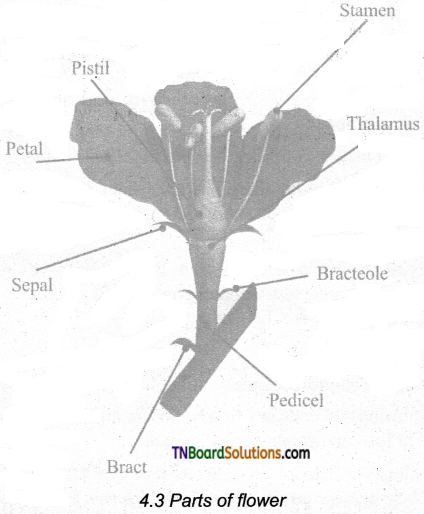
- Pistil The female reproductive organ of a flower is Gynoecium or pistil. Each member is carpel.
- Petal Innermost accessory whorl of the flower is corolla. Each member is called a petal.
- Sepal: Outermost whorl of the flower is calyx. Each member is called sepal.
- Perianth (perigonium) Undifferentiated calyx and corolla. Individual members are called tepal.
- Bract Subtending leaf or leaf-like the structure of any flower is called Bract.
- Stamen Male organ of a flower is the androecium. Each member is the stamen.
- Thalamus (torus or receptacle) The part of the flower on which other floral parts are attached.
- Bracteole: A smaller bract present on the side of the pedicel is called bracteole or bractlet. A whorl of bracteoles at the base of the calyx is called epicalyx.
- Pedicel Stalk of the flower. The flower is pedicellate or sessile depending upon presence or absence. The flowers with a short, rudimentary pedicel are called subsessile flowers.
![]()
Question 3.
What is Aestivation? Explain different types of aestivation.
Answer:
- Valvate Margins of sepals or petals do not overlap but just touch each other, eg. Calyx in members of Malvaceae, Calotropis, Annona.
- Twisted or convolute or contorted One margin of each petal or sepal overlapping on the other petal, eg. Petals of china rose.
- Imbricate: Sepals and petals irregularly overlap on each other; one member of the whorl is exterior, one interior, and the rest of the three having one margin exterior and the other interior, eg. Cassia, Delonix. There are three types: (i) Ascendingly imbricate, (ii) Quincuncial, (iii) Vexillary.
- Quincuncial It is a type of imbricate aestivation in which two petals are external and two internal and one petal with one margin internal and the other margin external, eg. Guava, calyx of Ipomoea, Catharanthus.
- Vexillary Large posterior petals both margins overlap lateral petals. Lateral petals other margin overlaps anterior petals, eg. Pea, bean.
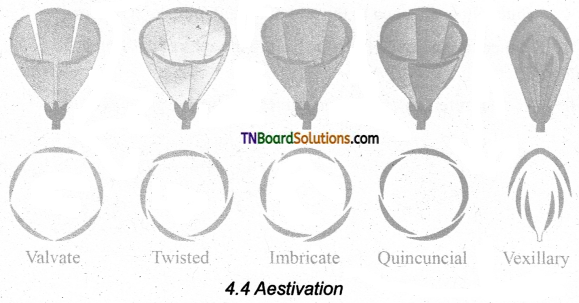
Question 4.
Describe the difference between anthers in plants.
Answer:
Anther types:
- Monothecal: One lobe with two microsporangia. They are kidney-shaped in a cross-section, eg. Malvaceae.
Some other types: Hfcplostemonous stamens are uniseriate and equal in number to the petals and opposite the sepals (antisepalous).
Obhaplostemonous: Stamens are uniseriate, a number equal to petals and opposite the petals (antipetalous)
Diplostetnonous: Stamens are biseriate, outer antisepalous, inner antipetalous. eg. Murraya.
Obdiplostemonous Stamens are biseriate, outer antipetalous, inner antisepalous. eg. Caryophyllaceae.
Poiystemonou Numerous stamens are normally many more than the number of petals. - Dithecal: It is a typical type, having two lobes with four microsporangia. They are butterfly-shaped in cross-section, eg. Solanaceae.
Anther attachment:
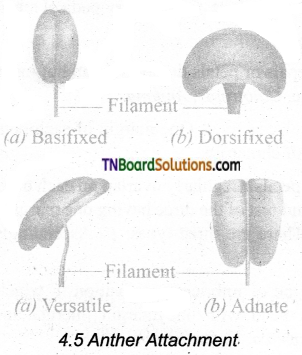
- Basifixed (Innate) Base of the anther is attached to the tip of filament, eg. Brassica, Datura.
- Dorsifixed Apex of filament is attached to the dorsal side of the anther, eg. Citrus, Hibiscus.
- Versatile: Filament is attached to the anther at the midpoint, eg. Grasses.
- Adnate: Filament is continued from the base to the apex of anther, eg. Verbena, Ranunculus, Nelumbo.
![]()
Anther dehiscence: It refers to the opening of anther to disperse pollen grains.
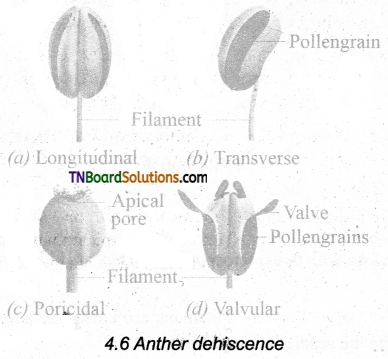
- Longitudinal: Anther dehisces along a suture parallel to long axis of each anther lobe, eg. Datura, china rose, cotton.
- Transverse: Anther dehisces at right angles to the long axis of anther lobe. eg. Malvaceae.
- Poricidal Anther dehisces through pores at one end of the thecae, eg. Ericaceae, Solarium, potato, brinjal, Cassia.
- Valvular: Anther dehisces through a pore covered by a flap of tissue, eg. Lauraceae, Cinnamomum.
Anther dehiscing direction: It shows the position of anther opening relative to the anther of the flower.
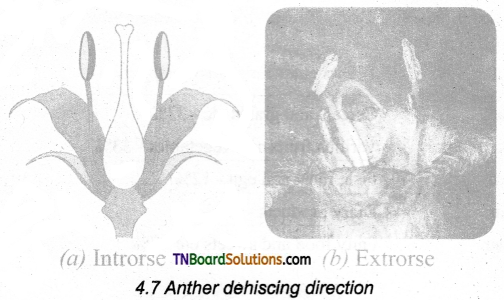
- Introrse: Anther dehisces towards the center of the flower, eg. Dianthus.
- Extrorse: Anther dehisces towards the periphery of the flower, eg. Argemone.
Question 5.
Explain the floral diagram and floral formula of Hibiscus Rosa Sinensis.
Answer:
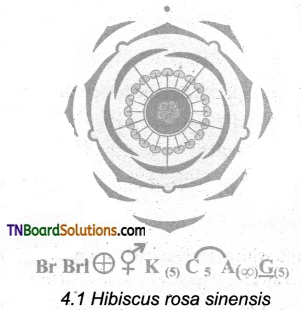
Question 6.
Write an essay on fleshy fruits and their kind.
Answer:
The fruits are derived from single pistils where the pericarp is fleshy, succulent, and differentiated
into epicarp, mesocarp, and endocarp. It is subdivided into the following.
- Ben Fruit develops from bi carpellary or multi carpellary, syncarpous ovary. Here the epicarp is thin, the mesocarp and endocarp remain undifferentiated. They form a pulp in which the seeds are embedded, eg. Tomato, Date Palm, Grapes, Brinjal.
- Drupe: Fruit develops from the monocarpellary, superior ovary. It is usually one-seeded. The pericarp is differentiated into outer skinny epicarp, fleshy and pulpy mesocarp, and hard and stony endocarp around the seed. eg. Mango, Coconut.
- Pepo: Fruit develops from tri carpellary, inferior ovary. Pericarp terns leathery or woody which encloses, fleshy mesocarp and smooth endocarp. eg. Cucumber, Watermelon, Bottle gourd, Pumpkin.
- Hesperidiur Fruit develops from the multi carpellary, multilocular, syncarpous, superior ovary. The fruit wall is differentiated into a leathery epicarp with oil glands, a middle fibrous mesocarp. The endocarp forms distinct chambers, containing juicy hairs, eg. Orange, Lemon. ,
- Pome: it develops from multi carpellary, syncarpous, inferior ovary. The receptacle also develops along with the die ovary and becomes fleshy, enclosing the true fruit. In pome the epicarp is thin skin-like and the endocarp is cartilaginous. eg. Apple, Pear.
- Balausta: A fleshy indehiscent fruit developing from multi carpellary, multilocular inferior ovary whose pericarp is tough and leathery. Seeds are attached irregularly with testa being the edible portion, eg. Pomegranate.
![]()
Activity
Text Book Page No. 121
Prepare a diet chart to provide a balanced diet to an adolescent (a school going child) which includes food items (fruits, vegetable, and seeds) which are non – expensive and are commonly available.
Answer:
Diet chart for school going child
| Carbohydrate | Cereals and grains etc – 33% |
| Vitamin and minerals | Various fruits and vegetables – 33% |
| Meat protein | Fish, meat, and egg -12% |
| Milk protein | Diary products -15% |
| Fat and sugar | Fatty food and sweets etc – 7% |
Choose the correct answer.
1. Axillary inflorescence is present in:
(a) Nerium oleander
(b) Theobroma cocoa
(c) Hibiscus rosa sinensis
(d) Couropita guianensis
Answer:
(c) Hibiscus rosa sinensis
2. An unbranched indeterminate inflorescence with sessile flowers is categorized as:
(a) spikelet
(b) spike
(c) simple raceme
(d) none of the above
Answer:
(b) spike
3. Umbeltypeofinflorescenceisseenin:
(a) Allium cepa
(b) Caesal pinia
(c) Cauliflower
(d) Opuntia
Answer:
(a) Allium cepa
![]()
4. Cyathium inflorescence consists of:
(a) Small bisexual flowers
(b) small unisexual flower
(c) small anthers
(d) none of the above
Answer:
(b) small unisexual flower
5. Which of the following is a monoecious plant?
(a) Musa
(b) Coconut
(c) Magnifera
(d) Papaya
Answer:
(b) Coconut
6. A piant with both male flowers and bisexual flower is termed as:
(a) androdioecious
(b) gynodioecious
(c) andromonoecious
(d) trioecious
Answer:
(c) andromonoecious
7. Flowers that lack any plane of symmetry and cannot be divided into equal halves in any plane are seen in:
(a) bean
(b) Datura
(c) Cassia
(d) Canna indica
Answer:
(d) Canna indica
8. A flower which is composed of distinct outer calyx and the inner corolla is termed as:
(a) Homochlamydous
(b) dichlamydeous
(c) achlamydeous
(d) none of the above
Answer:
(b) dichlamydeous
![]()
9. Match the following:
| (i) Anisomerous | (a) Allium |
| (ii) Bimerous | (b) Annona |
| (iii) Trimerous | (c) Hibiscus |
| (iv) Pentamerous | (d) Ixora |
(a) (i)-(d), (ii)-(b), (iii)-(a), (iv)-(c)
(b) (i)-(b), (ii)-(c), (iii)-(d), (iv)-(a)
(c) (i)-(b), (ii)-(a),(iii)-(d), (iv)-(c)
(d) (i)-(b), (ii)-(d), (iii)-(a), (iv)-(c)
Answer:
(d) (i)-(b), (ii)-(d), (iii)-(a), (iv)-(c)
10. Synsepalous condition is present in the flowers of:
(a) Annona
(b) Papaya
(c) Datura
(d) palmyra
Answer:
(c) Datura
11. Crciform type of corolla is present in:
(a) radish
(b) dianthus
(c) tea
(d) rose
Answer:
(a) radish
12. Flowerpetals fused to form a bell-shaped corolla are termed as:
(a) tubular
(b) Rotate
(c) Infundibuliform
(d) campanulate
Answer:
(d) campanulate
13. Corolla with two lips is present in:
(a) adhatoda
(b) linaria
(c) helianthus
(d) allium
Answer:
(a) adhatoda
14. Aestivation is the term used for:
(a) arrangement of flowers in the inflorescence
(b) arrangement of leaves in the stem.
(c) arrangement of sepals and petals in the flower bud
(d) none of the above
Answer:
(c) arrangement of sepals and petals in the flower bud
![]()
15. Match the following:
| (i) Monadelphous | (a) Asteraceae |
| (ii) Diadelphous | (b) Malvaceae |
| (Hi) Polyadelphous | (c) Fabaceae |
| (iv) Syngenesious | (d) Bombax |
(a) (i)-(d), (ii)-(b), (iii)-(a), (iv)-(c)
(b) (i)-(b), (ii)-(c), (iii)-(d), (iv)-(a)
(c) (i)-(b), (ii)-(a), (iii)-(d), (iv)-(c)
(d) (i)-(b),(ii)-(c), (iii)-(a), (iv)-(d)
Answer:
(b) (i)-(b), (ii)-(c), (iii)-(d), (iv)-(a)
16. Didynamous condition in which two stamens with long filaments and two with short filaments and two with short filaments, is seen in:
(a) Ipomoea
(b) Ocimum
(c) Mimosa
(d) Datura
Answer:
(a) Ipomoea
17. Innate condition of anther attachment is named for the condition:
(a) the base of anther is attached to the tip of the filament
(b) the apex of the filament is attached to the dorsal side of the anther.
(c) the filament is continued from the base to the apex of anther
(d) none of the above
Answer:
(a) the base of anther is attached to the tip of the filament
18. Poricidal type of anther dehiscence is present in:
(a) Cinnamomum
(b) Nelumbo
(c) Brinjal
(d) Datura
Answer:
(c) Brinjal
19. A condition in which the gynoecium has four carpels is termed as:
(a) bicarpellary
(b) multicarpellary
(c) unicarpellary
(d) tetracarpellary
Answer:
(d) tetracarpellary
![]()
20. Match the following.
| (i) Anthophore | (a) Gynandropsis |
| (ii) Androphore | (b) Capparis |
| (iii) Gynandrophore | (c) Grewia |
| (iv) Gynophore | (d) Silene canoidea |
(a) (i)-(d), (ii)-(c), (Hi)-(a), (iv)-(b)
(b) (i)-(b), (ii)-(c), (iii)-(d), (iv)-(a)
(c) (i)-(b), (ii)-(a), (iii)-(d), (iv)-(c)
(d) (i)-(b), (ii)-(c), (iii)-(a), (iv)-(d)
Answer:
(a) (i)-(d), (ii)-(c), (Hi)-(a), (iv)-(b)
21. In Malvaceae family the sepals, petals, and stamens are attached at the base of a superior ovary. This condition is known as:
(a) Perigynous
(b) Epigynous
(c) Epiperigynous
(d) Hypogynous
Answer:
(d) Hypogynous
22. Axile placentation is present in:
(a) Hibiscus
(b) mustard
(c) marigold
(d) cucumber
Answer:
(a) Hibiscus
23. Drupe fruit develops from:
(a) tricatpellary inferior ovary
(b) monocarpellary, superior ovary
(c) Bicarpellery ovary
(d) bicarpellary, syncarpous ovary
Answer:
(b) monocarpellary, superior ovary
![]()
24. Multiple or composite fruit develops from:
(a) the whole flower
(b) Single flower
(c) the whole inflorescence
(d) none of the above
Answer:
(c) the whole inflorescence
25. Match the following.
| (i) Berry | (a) Mango |
| (ii) Drupe | (b) Tomato |
| (Hi) Pome | (c) Cucumber |
| (iv) Pepo | (d) Apple |
(a) (i)-(d), (ii)-(b), (iii)-(a), (iv)-(c)
(b) (i)-(d), (ii)-(c), (iii)-(a), (iv)-(b)
(c) (i)-(b), (ii)-(a), (iii)-(d), (iv)-(c)
(d) (i)-(b), (ii)-(c), (iii)-(a), (iv)-(d)
Answer:
(c) (i)-(b), (ii)-(a), (iii)-(d), (iv)-(c)
26. In an inflorescence where flowers are borne laterally in an accropeted succession, the position of the youngest floral bud shall be:
(a) proximal
(b) Distal
(c) Intercalary
(d) Anywhere
Answer:
(a) proximal
27. Edible part of jack fruit is:
(a) whole fruit
(b) mesocarp
(c) perianth and seeds
(d) perianth and rachis
Answer:
(c) perianth and seeds
![]()
28. Non-endospermous seeds are present in:
(a) Groundnut
(b) Maize
(c) sunflower
(d) castor
Answer:
(a) Groundnut
29. Indicate the correct statement.
(a) Edible part of the fruit is poisonous to animals
(b) Edible part of the fruit is a source of food energy for animals.
(c) Edible part of the fruit is the exclusive source of medicine.
(d) Edible part of the fruit is the only source of fodder.
Answer:
(b) Edible part of the fruit is a source of food energy for animals.
30. In angiosperms embryo seed represents:
(a) female gametophyte
(b) male gametophyte
(c) sporophyte
(d) none of the above
Answer:
(a) female gametophyte